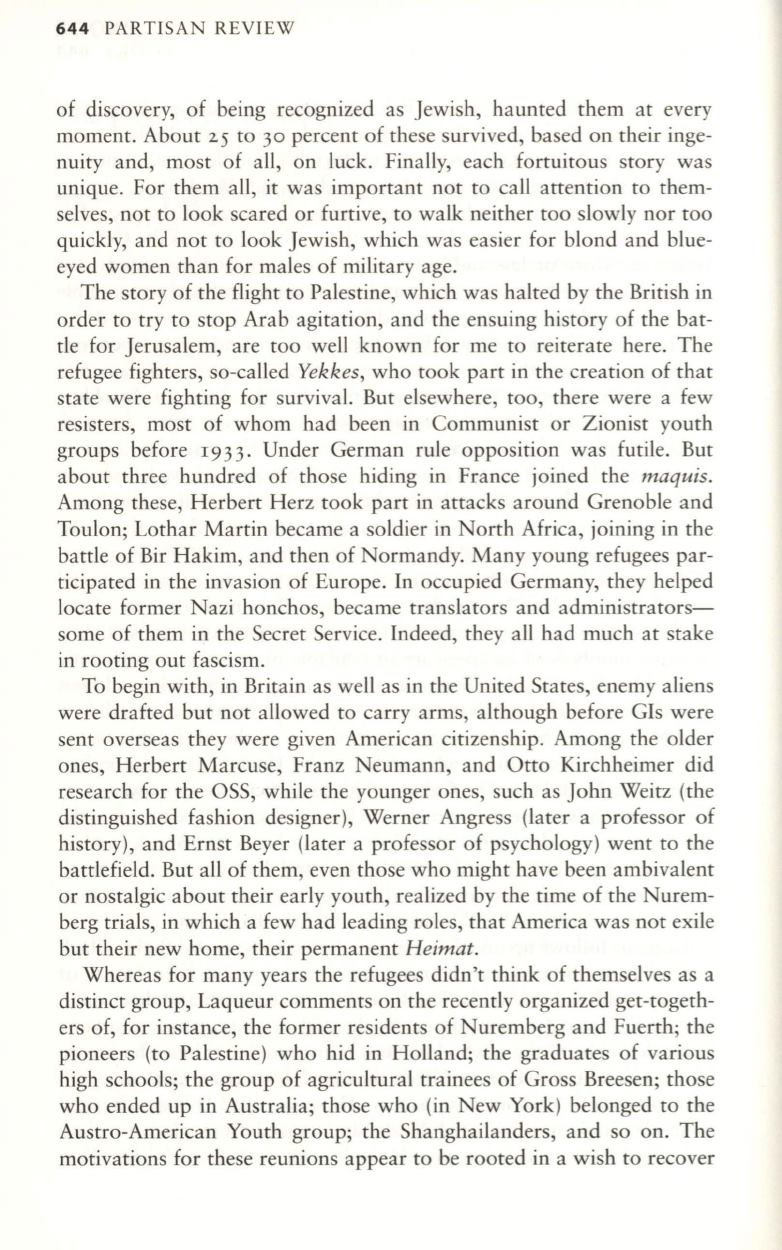
644
PARTISAN REVIEW
of discovery, of being recognized as Jewish, haunted them at every
moment. About 25 to 30 percent of these survived, based on their inge–
nuity and, most of all, on luck. Finally, each fortuitous story was
unique. For them all, it was important not to call attention to them–
selves, not to look scared or furtive, to walk neither too slowly nor too
quickly, and not to look Jewish, which was easier for blond and blue–
eyed women than for males of military age.
The story of the flight to Palestine, which was halted by the British in
order to try to stop Arab agitation, and the ensuing history of the bat–
tle for Jerusalem, are too well known for me to reiterate here. The
refugee fighters, so-called
Yekkes,
who took part in the creation of that
state were fighting for survival. But elsewhere, too, there were a few
resisters, most of whom had been in Communist or Zionist youth
groups before I933. Under German rule opposition was futile. But
about three hundred of those hiding in France joined the
maquis.
Among these, Herbert Herz took part in attacks around Grenoble and
Toulon; Lothar Martin became a soldier in North Africa, joining in the
battle of Bir Hakim, and then of Normandy. Many young refugees par–
ticipated in the invasion of Europe. In occupied Germany, they helped
locate former Nazi honchos, became translators and administrators–
some of them in the Secret Service. Indeed, they all had much at stake
in rooting out fascism.
To begin with, in Britain as well as in the United States, enemy aliens
were drafted but not allowed to carry arms, although before GIs were
sent overseas they were given American citizenship. Among the older
ones, Herbert Marcuse, Franz Neumann, and Otto Kirchheimer did
research for the OSS, while the younger ones, such as John Weitz (the
distinguished fashion designer), Werner Angress (later a professor of
history), and Ernst Beyer (later a professor of psychology) went to the
battlefield. But all of them, even those who might have been ambivalent
or nostalgic about their early youth, realized by the time of the Nurem–
berg trials, in which a few had leading roles, that America was not exile
but their new home, their permanent
Heimat.
Whereas for many years the refugees didn't think of themselves as a
distinct group, Laqueur comments on the recently organized get-togeth–
ers of, for instance, the former residents of Nuremberg and Fuerth; the
pioneers (to Palestine) who hid in Holland; the graduates of various
high schools; the group of agricultural trainees of Gross Breesen; those
who ended up in Australia; those who (in New York) belonged to the
Austro-American Youth group; the Shanghailanders, and so on. The
motivations for these reunions appear to be rooted in a wish to recover


